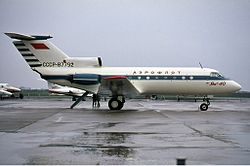Accident
The aircraft was operating Flight E-15 from Yerevan to Batumi, piloted by a crew from the 113th flight squadron, consisting of Captain (PIC) Suren Avetisovich Nersesyan, co-pilot Eduard Artashesovich Ovsepyan, and flight engineer Gennady Vladimirovich Azizyan. Also in the cockpit was a check-pilot, a senior instructor of the MGA, Nikolai Alexandrovich Loginov. The cabin crew included stewardess Rimma Misakovna Mikaelyan. There were 35 passengers on board, including 23 adults and 12 children. [2]
At 12:18 MSK Flight E-15 entered the airspace of Batumi Airport and the crew established communication with the air traffic controller. The controller gave permission to descend to 300 meters for the fourth turn and provided landing conditions with a magnetic course of 127°. At 12:25, the controller reported weather conditions: overcast with clouds at 420 meters, scattered clouds at 300 meters, visibility of 5 kilometers, and a southerly wind (195°) at 5–8 m/s. Although these conditions were above the required landing minima, the actual weather had deteriorated significantly, with visibility down to 3 kilometers and a lower cloud ceiling at 200 meters. [2]
When the aircraft was 11 kilometers from the airport, the controller cleared the aircraft to turn onto final approach and gave a heading of 139° as the aircraft was 2 kilometers to the left of the approach course. At 12:29:35, the controller informed the crew that the distance from the airport was 5 kilometers. The Yak-40 was between the coastline and the runway threshold, 1,300 meters from the runway threshold, when the check-pilot on board informed the controller that the crew intended to go-around. According to eyewitnesses, the aircraft flew over a point 2,700 meters northwest (azimuth 307°) of the runway threshold, almost on the landing course with a left turn. At this moment, the last communication from the controller to the crew occurred: "Can you make a visual approach?". "Yes, visual approach.". After this, the aircraft, still in the clouds, flew over the mountain Anaria. When the controller attempted to contact the crew again 170 seconds later, there was no response. [2]
Eyewitnesses reported that the Yak-40 made a right turn over the tea factory (9 kilometers from the airport reference point) along the valley of the Korolisckali River, then turned left to a magnetic course of 60°, and continued in this direction. Approximately 1,000–1,500 meters further on, the Yak-40 began a climbing right turn when at 12:34, at an altitude of 550 meters above sea level, on a course of 84°, right bank of 20°, and angle of attack of 14°, it collided with a mountain 594.6 meters high, 15 kilometers from the airport. The aircraft exploded and burned upon impact, killing all 40 people on board. [2]
Causes
According to the investigation, the weather information provided by the controller to the crew did not match the actual conditions. The flight operations supervisor knew that the weather reported by AMSG at 12:15 was below the necessary minima but did not take action to direct the aircraft to an alternate airport. The crew, in turn, initiated a go-around from an altitude of 150 meters and 1,300 meters from the runway threshold, likely due to deteriorating visibility on the final approach. The crew then entered clouds in mountainous terrain and decided to attempt a second approach without adequete conditions for visual flight. The decision to climb and transition to instrument flight came too late, leading to the collision with the mountain. The aircraft itself was fully operational and had no failures before the collision. [2]
The main cause of the accident was the significant deviation of the aircraft's flight path from the established procedure during the go-around.
Contributing factors: [2]
- Incorrect visibility information given to the crew (5 kilometers instead of 3 kilometers), with the airport's minimum visibility required to be 5 kilometers, and the lack of continuous radar control during the go-around.
- Inadequate meteorological support for the flight at the airfield, including infrequent 15-minute weather observations.
- The absence of terrain features higher than 200 meters in the procedure chart and flight production instructions at a distance of 5 kilometers from the scheme, while the actual altitude was 410 meters.
This page is based on this
Wikipedia article Text is available under the
CC BY-SA 4.0 license; additional terms may apply.
Images, videos and audio are available under their respective licenses.
